Better Know a… Province (Fujian) Posted by sasha on Jan 6, 2015 in Culture
Our journey across all corners of the Middle Kingdom continues down in the southeast in Fujian province (福建省 – fú jiàn shěng). The name comes from the combination of Fuzhou and Jianzhou (now known as Jian’ou), two cities in the province.
History
Fujian has a history going back thousands of years, as recent archaeological discoveries have shown. In the Warring States Period, the Yue clan moved south into the area after being defeated by the Chu. They went on to form the Minyue Kingdom (闽越 – mǐn yuè), which thrived until the Han Dynasty began conquering it by the end of the 2nd century BCE. Due to its location surrounded by mountains, it took repeat efforts for the Han to finally completely conquer Minyue.
Eventually, the area would see two huge waves of migration changing the makeup of the population. People flocked here due to the collapse of the Western Jin Dynasty and a combination of civil war plus invading nomadic peoples in the north. Later, in the time known as the Five Dynasties and Ten Kingdoms ( 五代十国 – wǔ dài shí guó) in between the fall of the Tang and rise of the Song Dynasty, another Min Kingdom was established here with its capital in Fuzhou. The Southern Tang soon took over, though.
The area eventually became a huge supplier of rice, sugarcane, tea, and other valuable goods. It also developed into a major shipbuilding and commercial center, trading with Arabs and Persians. These travelers brought Islam with them to China, and you can still see mosques across Fujian. Thanks to a ban on maritime commerce in the Qing and isolationist policies during the Ming, Fujian experienced a quick decline. During the Qing, Taiwan was also conquered and annexed as part of Fujian. This led to mass Han settlement in Taiwan – most people there today are descendants of Hoklo people from southern Fujian.
When Taiwan was separated, Fujian arrived at what are for the most part the modern-day borders. Although Fujian remained largely undeveloped thanks to its mountainous terrain and years of isolation, the port cities of Xiamen and Quanzhou have done much to quickly develop the province. Now Fujian faces a tough task of managing economic development and an ever-increasing population with preserving its landscape and resources.
Geography
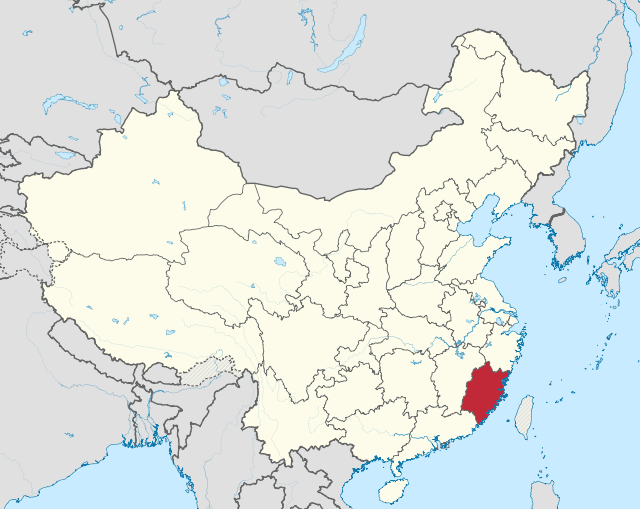
Fujian on the map.
You’ll find Fujian on the southeast coast of China, with the East China Sea to the east and South China Sea to the south. It shares a border with Zhejiang (north), Jiangxi (west), and Guangdong (south). Across the Taiwan Strait about 180 km and you’ll find yourself in Taiwan. Along the way, you’ll find some islands that are actually part of Fujian province and others that are part of Taiwan. Despite all of this coastline and the islands, Fujian is mostly mountainous. There’s even a saying that describes the geography of the province:
“Eight parts mountain, one part water, and one part farmland“
(八山一水一分田 – bā shān yī shuǐ yī fēn tián)
The Wuyi Mountains (武夷山 – wǔ yí shān) make up the border with Jiangxi, and they also feature the province’s highest peak at 2,157 meters. In addition to mountains, there are quite a few rivers running through Fujian, such as the Min River (闽江 – mǐn jiāng). Formed by the confluence of three other rivers, the Min is an important transportation channel.
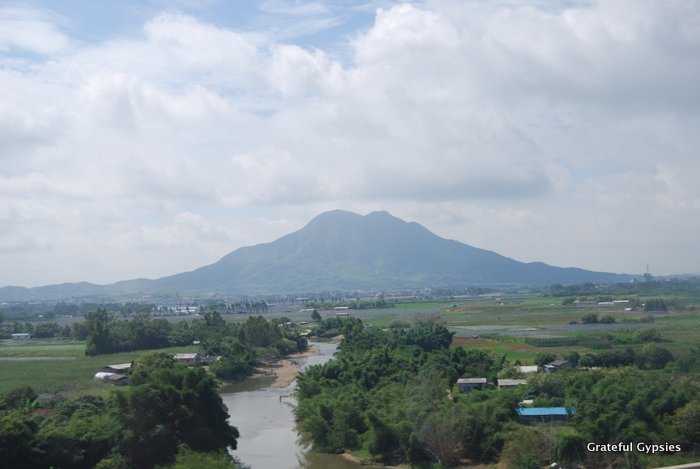
Scenery of Fujian as seen from a train.
Climate
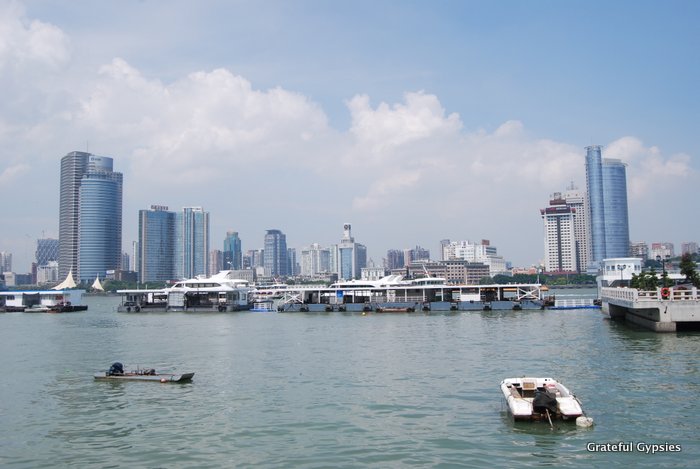
It’s nice and hot in Xiamen in the summertime.
The climate of Fujian can be classified as subtropical. Summers here are hot and rainy, with occasional typhoons coming in from the Pacific. August is generally the wettest month and the time when typhoons are most likely, so you may want to play your visit outside of this month. Winters are cool and pleasant for the most part, making Fujian province a good place to escape from some of the bitter cold regions of China at that time.
Population
There are about 37.5 million people who call Fujian province home, making it the 17th most populous region of China. While Han Chinese account for 98% of the local population, many subgroups exist here. In Fujian, you’ll find a lot of Min-speaking groups, such as: Hoklo, Hokciu, Teochew, and Putian people. Interestingly enough, they make up the majority of Han Chinese in Taiwan, SE Asia, and some parts of the United States. Another big subgroup are the Hakka (客家 – kè jiā) people, famous for their incredible tulou villages. In Fujian, the largest ethnic minority group is the She people (畲族 – shē zú), numbering at around 375,000.
Culture
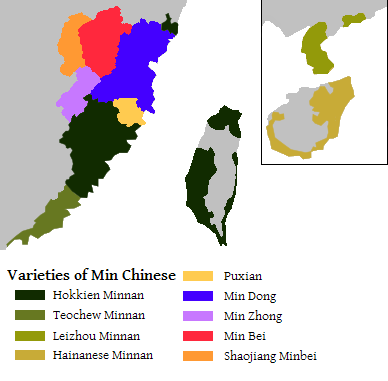
The many Min Dialects.
With so many different groups speaking so many different languages and dialects, Fujian is one of the most culturally and linguistically diverse places in all of China. In fact, it is said that “if you drive five miles in Fujian the culture changes, and if you drive ten miles, the language does.” This is due largely to the mountainous nature of the province and the many waves of migrants it has had through the ages. In addition, Fujian is also famous for its food. Fujian cuisine (福建菜 – fú jiàn cài), also known as Min cuisine (闽菜 – mǐn cài), is one of the Eight Great Culinary Traditions of China. Thanks to its location on the coast, there’s an emphasis on seafood. One of the most famous dishes is called “Buddha jumps over the wall” (佛跳墙 – fú tiào qiáng) – a complex kind of shark fin soup.
There are also many different varieties of Chinese opera throughout the province, including Minju (闽剧 – mǐn jù). Lots of famous tea comes from this province as well, such as oolong tea (乌龙茶 – wū lóng chá).
Famous Places
It should come as no surprise that most people come to Fujian for fun in the sun. Perhaps the most popular tourist destination in the whole province is the city of Xiamen (厦门 – xià mén). With accolades such as China’s 2nd place “city most suitable for living” and “most romantic leisure city,” tourists flock here in droves to relax on the beach and visit the small island of Gulangyu.
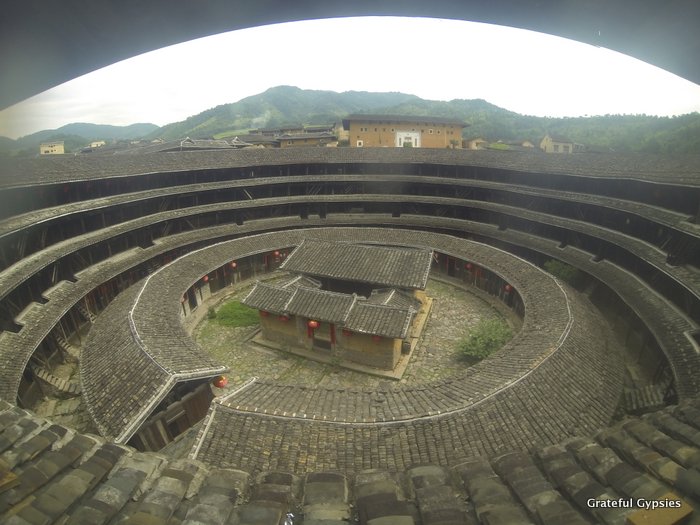
One of the province’s many tulou structures.
Another famous attraction in Fujian are the various tulou (土楼 – tǔ lóu) villages. Many of these traditional Hakka dwellings have been listed as UNESCO World Heritage Sites, noted as “exceptional examples of a building tradition and function exemplifying a particular type of communal living and defensive organization [in a] harmonious relationship with their environment.”
Other than these two major tourist sites, other places of interest include the above-mentioned Wuyi Mountains and a variety of temples and other important historical sites.

Build vocabulary, practice pronunciation, and more with Transparent Language Online. Available anytime, anywhere, on any device.
About the Author: sasha
Sasha is an English teacher, writer, photographer, and videographer from the great state of Michigan. Upon graduating from Michigan State University, he moved to China and spent 5+ years living, working, studying, and traveling there. He also studied Indonesian Language & Culture in Bali for a year. He and his wife run the travel blog Grateful Gypsies, and they're currently trying the digital nomad lifestyle across Latin America.




Leave a comment: